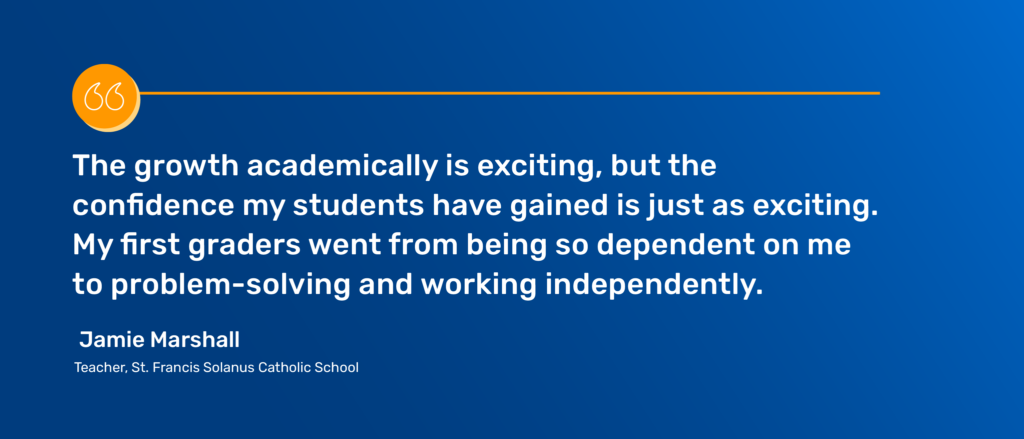Like many schools following the pandemic, St. Francis Solanus Catholic School in Quincy, Illinois, faced learning losses, including with their students’ reading abilities. It was clear to the teachers and staff that a new approach was needed to address literacy gaps and they began the work of reassessing how reading was being taught to students.
In the process of evaluating different approaches, the St. Francis team heard about IMSE and its Structured Literacy approach based on the science of reading. They ultimately decided to adopt this evidence-based approach and selected IMSE as their new partner. By incorporating IMSE’s explicit literacy instruction, St. Francis hoped to boost literacy outcomes for their early readers and overcome learning loss.
Before and After the IMSE Approach
In prior years, St. Francis implemented a Balanced Literacy approach to teaching reading. Jamie Marshall, a teacher who has been at St. Francis for thirteen years and the school’s current literacy interventionist, explained that the curriculum for each grade level didn’t align well, making it difficult for students to continue advancing in their reading abilities as concepts become more complex.
In addition, Jamie explained that the school’s prior reading instruction programs were challenging to implement with fidelity due to their lack of clarity and sequencing. Ultimately, they needed a solution that would help them fill the gaps for individual students, while aligning across classrooms and grades, and being easy to implement.
As the St. Francis team took the IMSE training and began implementing the new approach in their classrooms, the difference was clear. “I was kind of building the plane as I was flying it all year long, but I was so grateful for the fact that IMSE’s curriculum is black and white” Jamie says. “It’s very clearly laid out for teachers to easily implement.” Removing the guesswork and following a clear scope and sequence, Jamie and her fellow teachers were better able to gauge what students needed.
St. Francis’ Literacy Wins at a Glance
The St. Francis School’s hope for growth paid off as they observed student test scores and learning outcomes improving across their early elementary grades.
In 2023-24 Kindergarten classes:
- 93% of students achieved DIBELS fluency level.
- The Letter Naming Fluency score went from 30 mid-year to 80 at the end of the year.
- The scores for basic phonic skills, referred to as Nonsense Word Fluency and Correct Letter Sounds, went from 48 mid-year to 110 at the end of the year.
In 2023-24 1st Grade:
- 81% of students achieved DIBELS fluency level.
- One student jumped from 365 to 429 (From being in the red “intensive support” to yellow “strategic support”).
- Another student jumped from 388 (yellow) two levels to 481 (blue; top level – only core support needed).

“The improvements I have seen in students is absolutely incredible,” Jamie said. “The growth academically is exciting, but the confidence my students have gained is just as exciting. My first graders went from being so dependent on me to problem-solving and working independently.”
Jamie’s excitement to further build upon the success they have seen thus far is palpable. Improving literacy will be an ongoing focus among the St. Francis team and they are excited and hopeful for their students’ continued successes.
St. Francis’s literacy journey illustrates that timely gains can come from an evidence-based literacy approach, designed with a clear scope and sequence for easy implementation in the classroom. Stay tuned for a follow-up article about how St. Francis Solanus Catholic School worked with Literacy Advocates of West Central Illinois to make funding the training initiative possible.
If you would like to learn more about IMSE’s virtual and on-site training options for your school or district, visit the district training page.
Like what you read?
- Follow us on Facebook, Twitter, Instagram, LinkedIn, and Pinterest to learn more from IMSE.
- Check out IMSE’s training and digital resources.
